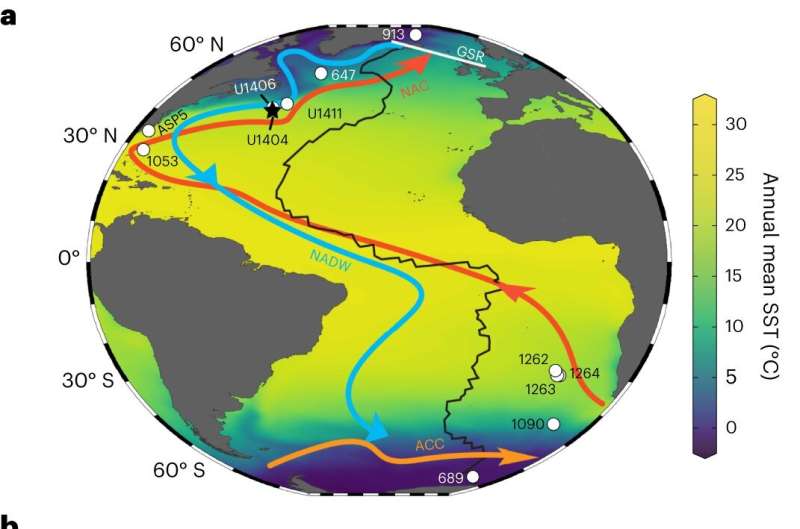This article has been reviewed according to Science X's editorial process and policies. Editors have highlighted the following attributes while ensuring the content's credibility:
fact-checked
peer-reviewed publication
trusted source
proofread
Study reveals evolution of modern-like Atlantic Meridional Overturning Circulation

The Atlantic Meridional Overturning Circulation (AMOC) influences global climate and marine ecosystems, redistributing oceanic heat and salt, interacting with the atmosphere, and ventilating the ocean interior. However, the timing and cause of the inception of this system and its evolution remain unclear.
Researchers from the Institute of Earth Environment of the Chinese Academy of Sciences (IEECAS), the University of Hong Kong, and the University of Southampton have found that modern-like AMOC emerged following the Eocene-Oligocene transition (EOT) about 34 million years ago (Ma), upon the initiation of large-scale Antarctic glaciation.
The study was published in Nature Geoscience on Oct. 16.
The researchers proposed a novel method for tracing oxygenation using microbial biomarkers. Microbial source indicators, based on distributions of glycerol dialkyl glycerol tetraethers (GDGTs), could indicate the contribution of other archaea/bacteria relative to the ubiquitous marine Thaumarchaeota.
"As non-Thaumarhaeotal microbes prefer to live in anoxic environments, the relative abundance of non-Thaumarchaeota, particularly methanogenic and/or methanotrophic archaea, in geological samples offers a method to evaluate the oxygenation status of past oceanic environments," said Wang Huanye from IEECAS, first author of the study.
The team then employed the microbial source indicators to infer the evolution of early AMOC. Results showed that, oxygenation of AMOC-feed waters decreased and culminated in especially poor ventilation towards the end of Eocene. AMOC-feed waters became better oxygenated at the EOT (~34 Ma) upon initiation of Antarctic glaciation, and were consistently well ventilated from ~30 Ma.
"This marks the onset of more modern-like AMOC at the EOT," said paleoceanographer Liu Zhonghui from IEECAS, corresponding author of the study, "and the onset of modern-like AMOC is probably triggered by Antarctic glaciation."
The timing and cause of the inception of Cenozoic AMOC would shed new light on the mechanisms driving this system. "Our work implies that both vertical mixing and Southern Ocean wind-driven upwelling are essential for sustaining modern AMOC," said paleoceanographer Paul A. Wilson from University of Southampton.
More information: Huanye Wang et al, Oxygenated deep waters fed early Atlantic overturning circulation upon Antarctic glaciation, Nature Geoscience (2023). DOI: 10.1038/s41561-023-01292-2
Journal information: Nature Geoscience
Provided by Chinese Academy of Sciences




















